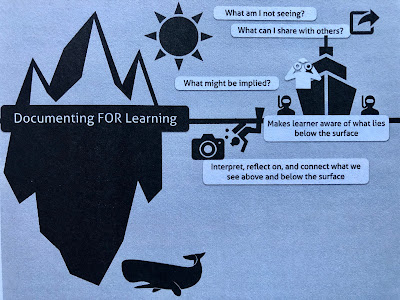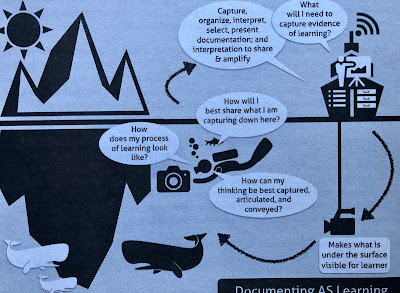I have joined the PYPC Bookclub and our first book is one that I was given personally by one of the authors who told me that I need to document my journey from teacher to consultant. The book is A Guide to Documenting Learning: Making Thinking Visible, Meaningful, Shareable, and Amplified by Silvia Rosenthal Tolisano and Janet Hale. I decided that Silvia would have loved it if I'd blogged about my reading and learning from her book, so I'm using this blog to take notes on my reading before our first meeting. There are likely to be a number of blog posts about this book, not least because I frequently lead the Evidencing Learning PYP workshop for the IB and because I think so much of what I'm reading about can be useful to me as a workshop leader, as well as for my participants. So here we go with my important take-aways from Chapter 1:
- Documenting means more than being organised or supporting learning by providing evidence. It involves accessing and reflecting on one's own learning process and articulating what is taking place through the learning journey.
- While anyone can document a moment in time by recording a video, taking a picture or writing down verbatim what is being said, documenting learning needs to be strategic and purposeful.
- Skills need to be developed to aid learners in understanding how media tools and platforms aid in capturing and sharing learning, as well as how media choices affect one's ability to demonstrate thinking and learning visible and/or auditorily.
Documenting OF Learning
Documenting of learning uses documenting as a snapshot product or performance artefacts that display learning moments. Documenting of learning is often overused. Learners recored everything and anything without necessarily interpreting what has been captured. Documenting of learning focuses on the product and the artefacts are observable, visible and/or audible to an onlooker. They are simply captured moments in time, whether shared in person, digitally or on social media. Documenting of learning is the visible portion of the iceberg that is above the water. When done at this surface level, documentation often feels like extra work for students and teachers, who see no real benefit or purpose beyond compliance.
Documenting FOR Learning
This uses interpretations of purposefully selected artefacts to convey evidence of meaningful visible and audible moments that take place during or because of the learning process. It is designed to raise awareness of a learner's changes, trends or patterns over time. Documenting for learning goes beyond simply capturing evidence of learning by digging deeper into the interpretation and application of what the artefacts convey. There are two types:
- Documentation for one's own learning purpose to track progress over time.
- Documentation wherein a learner makes his/her thinking and learning visible in order to help others learn when it is shared.



No comments:
Post a Comment